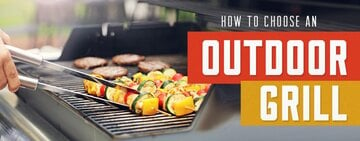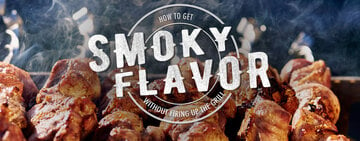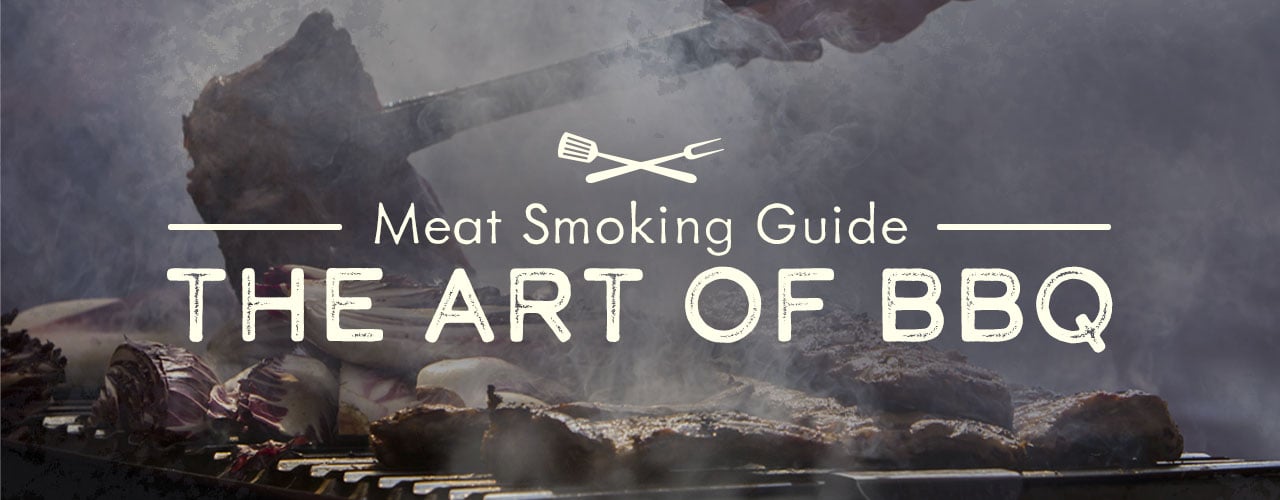
How to Smoke Meat
Last updated on 6/6/2022Some say cooking meat with smoke is a labor of love, others consider it an art form. Pitmasters use wood, smoke, and some basic equipment to turn tough cuts of meat into mouthwatering barbecue. Whether you're making Memphis-style BBQ or one of the other three regional American barbecue traditions, you must gain the equipment, tools, and techniques to prepare it. Go from a pit-novice to a pit-master with our meat smoking guide.
Shop All Smokehouse SuppliesHow to Smoke Meat in a Smoker

Hot smoking meat with wood is a time-honored tradition with some well-tested practices. Follow our tips below to learn how to smoke meat in a smoker and craft premium BBQ customers crave.
- Write out a BBQ schedule - Extensive cook times can lead to forgetfulness and fatigue. Ensure your meat is ready when you need it and don’t miss vital steps along the way by following a detailed schedule that outlines when to increase heat, wrap meat, and add your mop sauce. Incorporate a two-hour buffer period to accommodate the meat resting period and unexpected additional cooking time.
- Start with a clean smoker - Leftover residue creates creosote-filled smoke, which is dangerous. Grease that drips into your fire causes bad-tasting smoke and perverts the flavor of smoked meat.
- Truss your meat - Trussing (aka tying meat) with kitchen twine keeps its shape and allows it to cook evenly. Not just for chicken cuts, use trussing when smoking any uneven cut of meat.
- Tailor your wood size to your cooking time - Large cuts of meat with long cooking times require large wood chunks that range in size from a golf ball to a baseball. Wood pellets work well for fast-cooking items like fish.
- Smoke dry wood - While some love to experiment with soaking their wood in beer and other flavoring agents, damp wood causes uneven smoking.
- Use indirect cooking - When you smoke your meat with an indirect heat source, the meat drippings cannot fall into the fire and produce flare-ups or nasty tasting smoke.
- Aim for a light blue smoke - Light blue smoke has the best flavor.
- Burning wood is okay for smoking - It’s better to smoke meat with the clean smoke from burning wood than dark cloudy smoke created by incomplete combustion.
- Black smoke is bad - Pay attention to the color and consistency of the smoke. It should be a gentle, steady stream of blueish-white smoke. If the smoke is puffy, inconsistent, and gray/black, your wood is air starved. Dark smoke creates an unpleasant flavor in your meat. Add air to correct the problem.
- Only lift the lid at planned intervals - You will need to lift the lid to tend to the food, fire, and water pan, but you should not lift the lid otherwise. Try to perform all three maintenance functions at once. Preserving a smoky environment and even temperatures is critical for smoking succulent meats.
- Use smoke for half the cooking time - Adding too much wood and smoke will dominate the flavor of your meat and dry rub. After the first half of your cooking time elapses, allow heat to finish cooking your meats.
How to Arrange Meat in a Smoker
We recommend arranging your meat in an offset smoker. Always arrange your denser meats closer to the heat and arrange your lighter meats further away from the heat source. When arranging multiple types of meat in your smoker, you’ll need to know how long each type of meat usually takes to cook. Otherwise, your meats won't finish cooking at the same time.
How to Arrange Meat in a Vertical Smoker
Vertical smokers have higher temperatures at the bottom where their heat source lies. Arrange your heavier meats towards the bottom of your vertical smoker and lighter meats on a higher rack.
Best Smoked Meats
The best cuts of meat for smoking are full of fat and connective tissues (collagen). Smoking is an indirect cooking method that uses low temperatures and long cooking times. The cuts of meat we usually consider inferior quality are the stars of the meat smoking world. When the connective tissues have time to break down slowly, they convert to sugar and moisten the meat while it cooks. Smoked meats are a great example of the power of the Maillard reaction to enhance the complexity of food.
The three classic types of BBQ meat are beef brisket, pork shoulder, and ribs. Beginners to smoking meat should start out with easy and inexpensive cuts such as a Boston butt or picnic roast. Experts in the art of smoking may want to try their hand at smoking a prime rib or leg of lamb. We list the best meat to smoke in an eclectic smoker below, so you know exactly what to ask for when you go to your local butcher shop.
- Boston Butt - While its name suggests otherwise, Boston butt (also called pork butt) comes from the thick, marbled upper portion of a pig’s shoulder (aka the blade roast). It begins directly behind the pig’s neck and typically contains a small piece of its shoulder blade. When smoked, Boston Butt meat falls apart with ease, making it the ideal cut for pulled pork recipes.
- Picnic Cut - Also known as picnic shoulder/pork shoulder, the picnic cut is well-exercised pig shoulder meat. This arm roast begins where the Boston butt ends and continues down the leg to the hock.
- Brisket - Brisket comes from the breast of a cow. Lacking collarbones, cattle use their pectoral muscles to keep the front half of their 12000-to-1400-pound bodies off the ground. Their breast meat is dense, tough, and loaded with connective tissue. The point half of the brisket is used to make burnt ends.
- Pork Spareribs - The long cuts from the stomach to the shoulder of a pig are called spareribs. A rack of spareribs will have 11 to 13 bones that offer meat both atop and between the bones.
- St. Louis-Style Ribs - Characterized by their rectangular shape, butchers extract St. Louis-style ribs from a pig’s belly. Once removed, they trim away the breastbone, cartilage, and tips.
- Pork Back Ribs - Back ribs (also known as baby back ribs/loin ribs) come from the top of a pig’s rib cage below its loin muscle between the spine and spareribs. Baby back’s short, curved shape makes them easy to hold.
- Pork Country-Style Ribs - Cut from the shoulder blade end of the loin, country-style ribs are the leanest cut of pork ribs and offer the most meat per bone.
- Back Ribs - Beef back ribs are cut from behind the shoulder of a steer (the top dorsal area). Butchers remove the rib bones to access the prized prime rib roast. Butchers leave little meat on top of the rib bones, so most of the meat found on the back rib cut is between the bones.
- Plate Short Ribs - Plate short ribs come from the lower portion of a cow’s rib cage known as the short plate. Sandwiched between the brisket and flank steak cut, the short plate runs between the 6th and 10th rib. Nicknamed “brisket on a stick”, plate short ribs typically have 2” of meat on top and span 12”. This fatty cut of ribs does well with the low and slow cooking method.
- Chuck Short Ribs - Chuck short ribs come from below the chuck at the front of the steer. They’re shorter than plate short ribs and run from the 1st to the 6th rib.
- Whole Chickens/Turkeys - Smoked poultry is a lighter but equally delicious barbecued meat. It takes approximately 3 hours to smoke a whole chicken and between 6-10 hours to smoke a whole turkey.
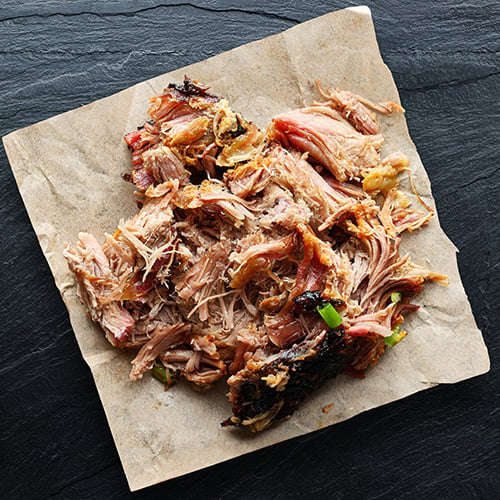
What Cuts of Meat Shouldn’t Be Smoked?
It’s a waste of time and money to slow smoke premium cuts of meat like steaks that grill well. We suggest saving your filet mignon for the sous vide and keeping your lean roasts and pork loins out of the smoker.
How Long Does Smoked Meat Last
If you refrigerate hot smoked meat within two hours of removing it from the smoker, it will last for four days. Tightly wrapped and frozen hot smoked meat lasts up to three months.
Cold smoked meat lasts months without freezing. Cold smoking preserves meat and dries it out, creating an unfriendly environment for the types of bacteria that spoil meat.
Back to TopSmoked Meat Temperature Chart
Use our smoked meat temperature chart when smoking meats:
| Meat Type | Smoking Temperature | Ideal Internal Temperature | USDA Minimum Temperature |
|---|---|---|---|
| Pork Butt/Shoulder | 225-275 °F | 195-205 °F | 145 °F |
| Pork Ribs | 225-275 °F | 195-205 °F | 145 °F |
| Pork Tenderloin | 225-325 °F | 145-150 °F | 145 °F |
| Beef Brisket | 225-275 °F | 190-210 °F | 145 °F |
| Chicken | 250-300 °F | 165 °F | 165 °F |
| Turkey | 250-300 °F | 165 °F | 165 °F |
| Fish | 225-250 °F | 165 °F | 165 °F |
Best Wood for Smoking Meat
Wood smoke affects the flavor of barbecued meats. Discover the four best woods for smoking meat below:
- Hickory Wood - If you can only stock one wood, order hickory. BBQ experts call hickory the universal wood for smoking meat. Hickory wood has an inherent sweetness and releases an abundance of smoke, creating the perfect sweet-savory combo. It lends well to large cuts of ribs, poultry, red meat, and pork shoulders.
- Mesquite Wood - Mesquite is a dense, hot burning wood with a rich, earthy taste. The powerful flavor of mesquite wood lends well to red meat, so it's the darling of beef-centric Texas style BBQ.
- Apple Wood - Choose apple wood if you want to add a sweet and fruity flavor to your smoked meat. Apple wood has a subtle flavor that takes time to develop, so it’s perfect for the low and slow BBQ method. It lends well to pork, chicken, ribs, and wild fowl.
- Oak Wood - Oak has a smoky flavor between apple and mesquite. You can use it on its own or blend it with other woods such as cherry, hickory, and apple. Pitmasters often use oak wood to smoke brisket, beef, and sausages, making it another popular choice for Texas style barbeque.
Worst Woods for Smoking
Avoid using softwoods in your smoker because they contain elevated levels of oil and resin that release dense, pungent clouds of smoke. The worst woods for smoking meat are spruce, pine, and fir. Across wood types, always discard rotten, waterlogged, or rotten pieces.
Best Size Wood for Smoking
The size of the wood you smoke meat with matters. Wood chips ignite quickly and burn fast, so they’re used with fast cooking items like steak, fish, and pork chops. Wood chunks burn steadily for hours in a smoker, making them the ideal size for low and slow smoked ribs, brisket, and pork butt. Pitmasters use logs as a source of smoke and fuel in large area pit barbeques and offset smokers.
What Is the Difference between Using Charcoal and Wood to BBQ?
Typically, the smoke from burning wood or charcoal creates the indirect heat used to BBQ. For the American BBQ tradition, burned wood smoke is the preferred heat source. When you burn wood, its natural flavor releases in its smoke, imbuing barbequed meats with earthy essences. Pitmasters tailor their wood selection to complement their meat menu.
Smoking vs Grilling
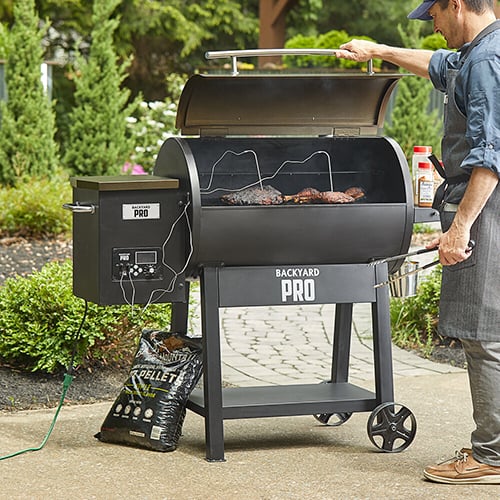
Smoking and grilling are two distinct cooking methods. Smoked meats are cooked low and slow over an indirect heat source (smoke) in an enclosed, circumvented cooking device. Grilling is a cooking method that exposes the surface of foods to a direct, dry heat source. Grill heat temperatures are over 350 degrees Fahrenheit and cook foods in under an hour (usually in a matter of minutes).
Large cuts of meat such as slabs of ribs, beef briskets, and pork shoulders become succulent and tender when you smoke them. Whereas grilling is perfect for smaller cuts of meat like fish, steak, and chicken breasts that aren’t filled with collagen.
What Is Smoked Meat?
Smoked meat is a protein that was exposed to smoke for the sake of cooking, flavoring, or preserving it. Smoking is one of the oldest cooking methods and has two styles: cold smoking and hot smoking. Hot smoking is how American pitmasters make barbecue, and cold smoking is the technique used to create smoked salmon.
What Is Cold Smoking?
Cold smoking is a method of preserving and flavoring foods by keeping them away from the direct heat source and exposing them to low-temperature smoke. The smoke is typically between 60-120 degrees Fahrenheit and will not cook food, so many butchers cure meats before cold smoking them.
What Is the Difference between Cold and Hot Smoking?
Hot smoking is another term for barbecue. Barbecue employs smoke between 200-300 degrees Fahrenheit to cook meat. Hot smoking flavors the surface of the meat with smoke and tenderizes meats by slow cooking them. In contrast, cold smoking uses cooler smoke to preserve and flavor meats but doesn’t cook them.
Back to TopTypes of BBQ Smokers
Below we've listed the types of commercial BBQ smokers you can purchase to churn out delicious low and slow-smoked meats:
- Commercial Indoor Smokers - BBQ restaurants with limited space and high traffic may require a commercial indoor smoker. There are full, half, and under-counter cabinet models, accommodating a variety of menu and space requirements.
- Pig Roaster - Perfect for Carolina-style whole hog BBQ, cook smokey, whole roasted pigs inside your commercial kitchen with pig roasters.
- Indirect-Heat Pit/Offset Smoker - Indirect-heat pits, also known as offset-smokers, have enclosed chambers that pull smoke, heat, and air from a firebox. This cooks the meat low and slow and creates a smokey flavor profile. Pitmasters fill their firebox with woods that complement their meat. Off-set smokers are popular for Texas-style BBQ. Some commercial outdoor grills come with a smoking function.
- Smoker Grills - Wood-fired pellet grills are diverse pieces of equipment that add woody flavor to grilled items. While smokers turn vegetables to ash, smoker grills give produce a smoky essence without overcooking them. Smoker grills are perfect for restaurants that want to test out smoking, special menu preparation, and outdoor catering applications.
- Subterranean Pit - Subterranean pits are underground pits that trap foods with an indirect heat source, cooking them evenly and saturating them in smokey flavors. Originally called Pachamanca, subterranean pits date back to the Inca Empire and are the earliest barbequing method. While uncommon, some old-school pitmasters still use subterranean pits.
Offset Smoker vs Vertical Smoker
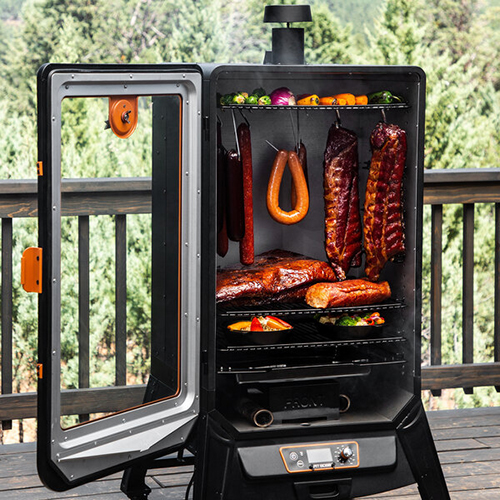
If you're wondering whether you should get an offset smoker or a vertical smoker, you'll need to consider the size of the meat you need to smoke and your operational goals. We explain the different benefits of offset smokers and vertical smokers below.
Pros and Cons of Horizontal Offset Smokers
- Offset smokers have a large cooking capacity and are ideal for smoking large cuts of meat like ribs, brisket, and whole hog BBQ.
- Many pitmasters swear offset smokers create the most authentic barbecue flavors.
- Most offset smokers can double as a grill if you switch their cooking chamber to grates and create a charcoal pit, making them a versatile investment.
- Offset smokers are more affordable than vertical smokers.
- Since they don't need electrical power, you can use your offset smoker anywhere.
- Offset smokers require more labor, fuel, and lose heat faster than vertical smokers.
Pros and Cons of Vertical Smokers
- Vertical smokers have a smaller footprint and require less fuel than offset smokers.
- You can yield a high output with vertical smokers because they smoke meat much faster than offset smokers.
- Vertical smokers are both portable and hold their heat in cold environments, making them ideal for mobile food businesses.
- While many vertical smokers have double doors for easy fuel replenishment, their narrow designs make it hard to add, rotate, and remove your meats. Adding fuel to vertical smokers without double doors is difficult and time-consuming.
- Small vertical smokers may not accommodate large cuts of meat, so you may have to hang ribs from a hook instead of smoking them racked, which often leads to unevenly cooked meat.
Meat Smoking Equipment
Invest in meat smoking equipment so you can start creating delicious smoked proteins. Here are the top 6 smoking tools you’ll need:
- Smoker - There are a variety of commercial smokers you can purchase. Most manufacturers categorize them by how they generate heat.
- Wood - Hardwoods work best for smoking. Research the ideal type and size of wood for your smoker.
- Thermometers - Invest in quality BBQ thermometers to assess your smoke and meat temperatures.
- Water Pan - Use a water pan to create humidity inside your smoker’s cook chamber. The moisture helps the meat absorb the smoke and prevents it from drying out.
- Spray Bottle - Certain sections of meat are more prone to drying than others, so you’ll need to use a spray bottle to moisten vulnerable areas during each cook session. Spray bottles with adjustable nozzles work best. You’ll want to release equal parts mist and stream. A pure mist spritz will evaporate before reaching the meat, but a pure stream may dampen the wood.
- Drip Pan - If your smoker doesn’t have a pre-installed drip pan, you’ll need to add a large, shallow pan underneath its grate. Meat releases grease and rendered fat during the long smoking process. These drippings can turn rancid or cause fires when left unchecked.
Meat Smoker Accessories
Stock-up on these must-have BBQ smoker accessories:
- Heat Resistant BBQ gloves
- BBQ Grill Brush
- BBQ Tongs
- Basters
- Butcher’s Block
- Boning Knife
- Rib Racks
- Shredding Claws
What Is Pit BBQ?
Pit BBQ is not a dish or a cooking device, it is a method of slowly cooking foods using indirect heat from smoked wood or charcoal. In contrast, pit cooking is the act of roasting meat in a large, level hole in the ground. To start, load a stack of logs approximately 2 1/2 times the volume of the pit into the earth and set them ablaze. Allow the hardwood to burn until it reduces, then half fill the pit with burning coals. This process requires 4 to 6 hours of burning time.
Back to TopSmoking is a wonderful way to transform tough cuts of meat into gourmet meals. If done correctly, smoking meat can infuse a ton of flavor into your meat dishes. Whether you want to add smokey brisket nachos to your appetizer list or create a full-fledged BBQ menu, our guide to smoking meat can teach you everything you need to know.

